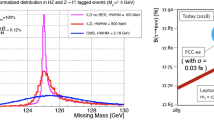Abstract
Background
The Circular Electron Positron Collider (CEPC) is a large international scientific facility proposed to study the Higgs boson in great detail. It requires state-of-the-art detectors, including extremely precise vertexing and tracking devices, such as a silicon vertex detector.
Purpose
Silicon vertex detector with the precision required by the CEPC has never been built before and needs extensive research and development. This paper describes the mechanical design of a vertex detector prototype being built to explore the required technologies and the major challenges.
Methods
The exceptional high spatial resolution of the CEPC vertex detector is achievable only with a detector of extremely low mass to limit particle scattering. This paper proposes a mechanical design for the vertex detector prototype, highlighting the choice of low-mass materials, the analysis of support structures, the solution of detector cooling issues, and the drafts of procedures for detector assembly.
Results
The ultra-light support of the ladder (a structural unit of the CEPC vertex detector prototype), which is mainly made of carbon fiber reinforced polymer composite, has been designed. The fabrication process has also been verified. Global supporting and cooling method of the vertex detector prototype has been designed and chosen with results from finite element analysis and computational fluid dynamics simulations. Complete assembly and installation schemes for the prototype have been developed, and the respective tooling has also been designed. The performance of the vertex detector prototype, using this low-mass mechanical structure, was demonstrated with fast simulation to closely meet the CEPC physics requirement.
















Similar content being viewed by others
References
The CEPC Study Group, CEPC Conceptual Design Report: Volume 2—Physics & Detector. arXiv:1811.10545
B. Abelev et al., The ALICE Collaboration, Technical design report for the upgrade of the ALICE inner tracking system. J. Phys. G Nucl. Part. Phys. 41, 087002 (2014)
G. Contin, L. Greiner, J. Schambach et al., The STAR MAPS-based PiXeL detector. Nucl. Instrum. Methods A 907, 60–80 (2018)
T. Abe, I. Adachi, K. Adamczyk, et al. Belle II Technical Design Report. arXiv:1011.0352
M. Friedl, K. Ackermann, H. Aihara et al., The Belle II silicon vertex detector. Nucl. Instrum. Methods A 732, 83 (2013)
M. Schnell, The Belle II Pixel Detector for the SuperKEKB Flavour Factory, in The 23rd International Workshop on Vertex Detectors (Vertex 2014), The Czech Republic, September 15–19, 2014, PoS (Vertex2014) 016.
G. Bianchi, TkLayout: a design tool for innovative silicon tracking detectors. J. Instrum. 9(03), C03054 (2014)
T. Wu, R. Casanova, W. Wei et al., A full functional Monolithic Active Pixel Sensor prototype for the CEPC vertex detector, in 26th IEEE International Conference on Electronics, Circuits and Systems (ICECS), pp. 510–513 (2019)
X. Wei, W. Wei, T. Wu et al., High data-rate readout logic design of a 512 × 1024 pixel array dedicated for CEPC vertex detector. J. Instrum. 14, C12012 (2019)
J. Galos, Thin-ply composite laminates: a review. Compos. Struct. 236, 111920 (2020)
C. Huang, M. He, Y. He et al., Exploration relation between interlaminar shear properties of thin-ply laminates under short-beam bending and meso-structures. J. Compos. Mater. 52, 2375–2386 (2018)
A. Nomerotski, O. Bachynska, J. Baudot et al., PLUME collaboration: ultra-light ladders for linear collider vertex detector. Nucl. Instrum. Methods A 650, 208–212 (2011)
G. Aad, B. Abbott, D.C. Abbott et al., Alignment of the ATLAS inner detector in Run-2. Eur. Phys. J. C 80, 1194 (2020)
C. Ye, B. Yan, Z. Xu, Deformation performance of high strength silicon carbide ceramic foams. J. Build Mater. 9(5), 543–547 (2006)
Acknowledgements
The research was supported and financed by the National Key Research and Development Program of China under Grant No.2018YFA0404302.
Author information
Authors and Affiliations
Corresponding author
Ethics declarations
Conflict of interest
On behalf of all authors, the corresponding author states that there is no conflict of interest.
Rights and permissions
About this article
Cite this article
Fu, J., Liang, Z., Zeng, H. et al. Mechanical design of an ultra-light vertex detector prototype for CEPC. Radiat Detect Technol Methods 6, 159–169 (2022). https://doi.org/10.1007/s41605-021-00310-4
Received:
Revised:
Accepted:
Published:
Issue Date:
DOI: https://doi.org/10.1007/s41605-021-00310-4




